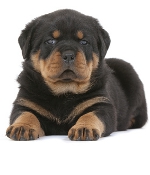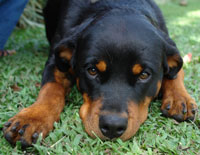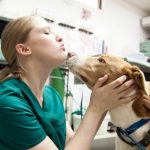If you’re the proud owner of a new puppy, you’ll find that a reliable source of free puppy training tips makes the next few weeks a whole lot easier.
In This Article You Will Read About
That little bundle of fur may be a baby right now, but you’ll be amazed at how quickly he grows…. and a Rottweiler puppy is going to grow A LOT!
Puppy training begins the day you get your little guy or girl home…… and when you start out the right way, it makes the whole process much quicker (and less stressful for everyone).
If you want him to grow up to be a happy, well-adjusted, sociable, and obedient dog you need to take some time right now to teach him some basic manners and obedience commands.

An untrained or unruly/disobedient puppy will become an untrained unruly/disobedient dog, and that will not lead to a happy life for anyone – dog or owner.
Many dogs are abandoned every year for ‘behavioral’ issues (such as housebreaking problems or excessive biting and so on). The majority of these could have easily have been prevented in the first place with a little bit of time and effort.
So don’t let your puppy become a statistic! Instead, take advantage of these free puppy training tips and give him the gift of a long, happy family life.
How To Train Your Puppy
Training a puppy isn’t difficult, and it should always be fun (for both you and your puppy), but there are some basic guidelines that you need to follow if your want your puppy training efforts to be successful.
There are two main types of puppy training that you’ll be concerned to begin with…… house training or house breaking and basic obedience/manners.
House training involves teaching your puppy to eliminate outdoors (or if necessary, but not recommended, on pee pee pads/litter tray indoors) and you’ll find all the information you need (and more free puppy training tips) about this aspect of puppy training on my Housebreaking A Puppy page.
Basic puppy obedience training and ‘manners’ needs to be taught at the same time, and you’ll start out slowly and build up.
Depending on how old your puppy is when you bring him home, and what sort of environment he spent his first few months of life in, you may even have some re-training to do, or some behavior problems to deal with.
Learning to be sociable and confident with other people, dogs and situations is also an important aspect of your puppy’s lessons. You’ll need some free puppy training tips to cover this area too.
Although your new puppy is a smart little guy, and is eager to ‘soak up’ all the experiences and lessons that he can, he has a very short attention span! Any ‘teaching’ at this age needs to be given in very short ‘bursts’ and the key words here are ‘little but often’.
Rottweilers are very intelligent dogs, and they’re always eager to please. I have owned other breeds, and I can honestly say that in my experience Rottie pups make great (and very willing) students :o)
Here is a list of some important free puppy training tips that will help you start out the right way…….
Tips For Training A Pup The Right Way!
- Make puppy training sessions a fun experience
- Only use positive reinforcement (treats, praise, toys etc.)
- Never shout at, or punish, your puppy if he isn’t successful
- Practice one command or behavior at a time when your pup is small
- Sessions should be short (maybe 2 – 3 minutes to begin with)
- Practice at least 3 times a day. Build this into your daily routine, EVERY day
- Be consistent in your methods and corrections
- Always end a session on a positive note (with your pup being successful)
- Never train your puppy when you’re feeling angry, upset or frustrated
Puppy training isn’t just a way of teaching your puppy about the right way to behave in our human world, but about building the relationship between you. The free puppy training tips above will help you do both.
Your puppy loves you no matter what, but in order to fully trust you he has to feel that you know what you’re doing and that you are able to take care of him. He’ll look to you for leadership, direction and answers, and if you can’t provide them he’ll make up his own. That is not what you want!
Puppy Obedience Training Tips:
Learn the basic dog obedience training commands in German here….
German Dog Commands
You don’t want to wait for your pup to start attending a Puppy Obedience Class before he learns his first commands.
He’ll most likely have several weeks with you before he’s fully vaccinated and able to be around other puppies,
So it’s important to make the most of those weeks by helping him to understand some of the basics at home.
Name Recognition
Although you probably spent lots of time and energy looking at Rottweiler names for your puppy, he doesn’t even know (or care!) what his name is. So, the first thing you want to do is get him to learn that when he hears his name he needs to pay attention.
Most puppies LOVE treats, and food makes a great reward. Choose quiet moments when your pup is paying attention to you and say his name, then give him a tiny treat. Do this half a dozen times.
Once he’s familiar with this and has learned to associate his name with a treat, try saying it when he’s not already paying attention to you (but not when he’s fully absorbed in a tasty bone or playing with the cat).
When he responds by looking at you, then give him a treat. If your practice this daily, your little guy will learn his name very quickly.
The ‘Sit’ Command
This is usually the easiest basic puppy obedience command to teach. Here’s a simple way to do it….

Get a handful of tiny, tasty treats and then get your puppy’s attention. Hold one of the treats right in front of his nose and ask him to ‘sit’ in a firm, calm voice. Then move the treat slowly up and back over his head.
Your little guys’ nose will follow the treat upwards, and his rear end will go downwards! As soon as his little butt hits the floor, tell him “good sit” and give him a treat and praise. Again, practice a few times each session.
Teaching The ‘Recall’ (or ‘Come!’) Command
When it comes to teaching your pup to ‘come’, the following free puppy training tips could be lifesavers! That’s because the ‘recall’ is probably THE most important puppy obedience command there is.
The aim is to get your pup to respond to your ‘come’ command without hesitation, and without even thinking that there’s an option.
Just think about it. If you open the front door and your puppy slips through and is off down the street in the blink of an eye, imagine what kind of trouble he could get into. But, if he’s learned that when he hears “Brutus come!”, he needs to stop in his tracks and do just that – he’ll be a whole lot safer.
The most important of the free puppy training tips related to the recall, is NEVER to practice this if your puppy has an option to ignore your command. Puppies are creatures of habit, and learn through association. If your little guy gets into the habit of coming to you everytime you say “Brutus come”, it will be ‘hardwired’ into his brain. He’ll do it instinctively. The same applies if he learns that he can ignore you!
So, always practice the recall with your pup on a long training leash (or even a long piece of light rope). Get his attention by saying his name, and then in a happy, excited voice, say “Brutus come” and crouch down, clap your hands or do whatever you can to encourage his little legs to get him to you asap. Give him a tasty treat and lots of praise as soon as he reaches your arms.
You can do this inside your house to begin with, then move out to the yard, then even the street or local park etc. (once he’s had all his canine vaccinations of course), but always have him on a leash.
He needs to be 100% reliable, no matter what the distraction, before you can let him off-leash and expect him to come back.
This will be unlikely to happen until he’s in an Intermediate Dog Obedience class, so don’t rush things.
The ‘Down’ Command
This can be a bit more difficult to teach, as some puppies resist lying down on command, especially the more ‘alpha’ or dominant ones.

But if you start early, and are consistent with your practice, your little guy should learn pretty quickly.
It’s best to leave this command until after your pup has mastered the ‘Sit’ command. That’s because it’s easier to get a pup into the ‘down’ position from a ‘sit’ than from when he’s standing firmly upright on all four paws!
Once your pup is sitting nicely, take another treat and hold it in front of his nose. Then this time, slowly lower the treat to the floor, moving slightly away from the pup and towards you as you do so. Your puppy’s nose should follow the treat downwards, and his legs will slide forward to help him reach it better. Aim to be holding the treat on the ground, between his two front paws when he’s lying down.
Some pups ‘get this’ right away, others seem to struggle a bit and try to bend themselves around like a pretzel to avoid lying all the way down. If your pup does this, help him out by using your free hand to gently pull his front legs forward so that his tummy gets to ground level.
As soon as he’s lying down, say “good down” and give him his treat and a lot of praise. Don’t overdo the repetitions on this one, do it 2 or 3 times, and then move on. Just make sure to practice several times a day.
The ‘Leave It’ Command
When it comes to puppy training, teaching your pup the ‘leave it’ command is one that is often overlooked, which is a pity because it’s a very versatile and useful command.

Rottweilers are a guardian breed, and they will naturally ‘guard’ you, protecting you from threats…. but they shouldn’t guard objects (such as toys or bones etc.) from you!
Food-guarding, or possession-guarding, is actually pretty common in puppies of all breeds, and the more treasured the object the more intense the desire to protect it from predators.
This is a natural canine behavior and in the wild I imagine it fits in pretty well, but in a human household it’s a ‘no-no’ and any attempts need to be discouraged from day one.
It’s best to start teaching your Rottie pup the ‘leave it’ command when he’s playing with one of his toys, but not an edible one. Get a few of his favorite treats in your hand and then ask him to ‘leave it’, simultaneously removing the toy from his possession. If it’s in his mouth, don’t tug or he’ll think it’s a game, instead gently open his mouth and take it out instead.
As soon as you have the toy, tell your pup “Good Leave It”, and give him a treat. The immediately give him back his toy – you want him to give it up to you next time you ask and if you take it away now he’ll resist in the future!
Practice this way several times a day for a week or so, then move on to removing a bone or edible chew toy. As with all the other commands in the free puppy training tips above, you need to practice regularly so that the desired behavior becomes an instinctive reaction, a habit, and your pup obeys without even thinking about it.
The ‘leave it’ command comes in very handy if your pup gets hold of something he shouldn’t, or something dangerous, or is inclined to pick up all sorts of junk when out walking. In fact in some cases (such as finding something toxic) it could actually save his life.
If your puppy shows any tendency to ‘guard’ his food bowl, toys, bones etc., you need to follow certain steps to make sure he doesn’t get comfortable protecting his ‘stuff’ from the humans in his household!
There are also certain steps you can take to make sure that food or resource guarding doesn’t ever get started, check out my page on dog food aggression to learn how to prevent, or deal with, food guarding in dogs and puppies.
Leash Training Your Puppy
Puppy leash training needn’t be a struggle if you approach it the right way! Learn exactly how to leash train your pup by visiting my Leash Training A Puppy page. Consider getting an escape proof harness like the ones listed here to use with the leash.
Final Thoughts On Puppy Training….
These points are worth re-emphasising…..
- More frequent training sessions are better than longer training sessions.
- Consistency & repetition are vital to your (and your puppy’s) success
- Only ever use positive training methods. Always reward rather than punish.
There’s a huge range of dog training equipment available and having the right ‘stuff’ can really make training your pup a whole lot easier!
Check out my Dog Training Tools page to see a selection of some of the best items around!
Related Pages….

